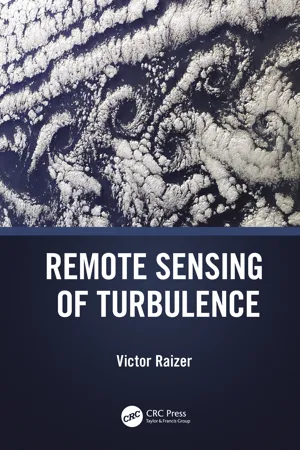
- 257 pages
- English
- ePUB (mobile friendly)
- Available on iOS & Android
Remote Sensing of Turbulence
About this book
This book offers a unique multidisciplinary integration of the physics of turbulence and remote sensing technology. Remote Sensing of Turbulence provides a new vision on the research of turbulence and summarizes the current and future challenges of monitoring turbulence remotely. The book emphasizes sophisticated geophysical applications, detection, and recognition of complex turbulent flows in oceans and the atmosphere. Through several techniques based on microwave and optical/IR observations, the text explores the technological capabilities and tools for the detection of turbulence, their signatures, and variability.
FEATURES
-
- Covers the fundamental aspects of turbulence problems with a broad geophysical scope for a wide audience of readers
-
- Provides a complete description of remote-sensing capabilities for observing turbulence in the earth's environment
-
- Establishes the state-of-the-art remote-sensing techniques and methods of data analysis for turbulence detection
-
- Investigates and evaluates turbulence detection signatures, their properties, and variability
-
- Provides cutting-edge remote-sensing applications for space-based monitoring and forecasts of turbulence in oceans and the atmosphere
This book is a great resource for applied physicists, the professional remote sensing community, ecologists, geophysicists, and earth scientists.
Frequently asked questions
- Essential is ideal for learners and professionals who enjoy exploring a wide range of subjects. Access the Essential Library with 800,000+ trusted titles and best-sellers across business, personal growth, and the humanities. Includes unlimited reading time and Standard Read Aloud voice.
- Complete: Perfect for advanced learners and researchers needing full, unrestricted access. Unlock 1.4M+ books across hundreds of subjects, including academic and specialized titles. The Complete Plan also includes advanced features like Premium Read Aloud and Research Assistant.
Please note we cannot support devices running on iOS 13 and Android 7 or earlier. Learn more about using the app.
Information
Table of contents
- Cover
- Half Title
- Title Page
- Copyright Page
- Contents
- Preface
- Author
- List of Acronyms
- 1 Turbulence: Introductory Overview
- 2 Geophysical Turbulence
- 3 Elements of Wave Propagation Theory
- 4 Remote Sensing Tool
- 5 Turbulence Observations
- Appendix
- Index